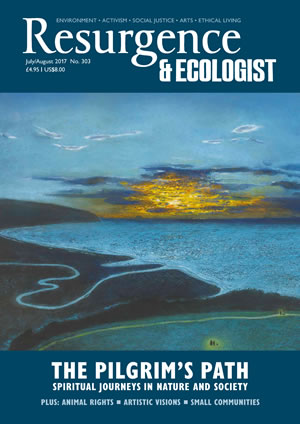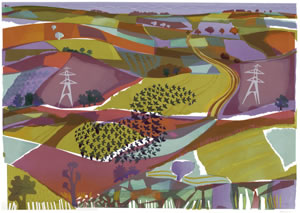We live in a fragmented world. The lines that cause the fragmentation are made by us; we have created a linescape of our landscape. We need to relearn the art of reconnection for the good of ourselves and the ecosystems we threaten.
Let’s begin with a little paradox. The first lines we etched into the land were specifically designed to fragment it, to chop it up into pieces; asserting ownership and restraining livestock. Yet these walls, hedges, ditches and dykes have inadvertently become the agents of connectivity in the landscape for much wildlife. The second wave of lines were all for communication: canals, railways and roads. And these have become agents of fragmentation in the landscape.
Have a look out of the window on your next train journey and start to find the lines that bind us. From garden fences to motorways, the way we compartmentalise the environment is important. All species have a minimum requirement of area for survival. For example, we know that hedgehogs need at least 90 hectares of the best-quality habitat to be able to have a viable population. The fact that Britain’s hedgehog population has been declining precipitously is largely down to a lack of areas of suitable size. And what is true for hedgehogs is true for all wildlife.
The patchwork of Britain – whether that is the hedgerows and walls of the countryside or the small gardens of suburbia – is one of our defining features. The mosaic allows wildlife to flourish, or at least survive, in what could be otherwise hostile environments. But we have allowed the lines to deteriorate. The once well-laid hedges now thinning into rows of trees held together by barbed wire have lost much of their potential. The roads, once green lanes of life, have become lethal slices through the land, mauling those who dare to cross.
Yet for all the lines that fragment the land, there are lines that stitch our country together. Drystone walls that act as the thoroughfare for small mammals, spiders, birds, amphibians and reptiles across higher ground; railway lines that offer a refuge and a path into and out of the city.
The more I have investigated our linescapes, the more I have realised how vital they are for reversing the damage we cause to the Nature we must all share. Not just because fragmenting the habitat of animals and plants accelerates their extinction, but also because we are as in need of the connections these lines can offer as any other species. These lines are the routes by which Nature can come to us and we can go to Nature. If we remain removed from Nature we will lose the love necessary to fight for its protection.
We can make some headway – at the level of our gardens – by making sure there are holes in fences to allow hedgehogs and other less flighty beasts to move. This is at the heart of the campaign I helped launch called Hedgehog Street. People love hedgehogs – they frequently top polls of Britain’s favourite animal – and want to help them. When there are, for example, connected gardens, log piles, compost heaps, pollinator plantings and accessible ponds, so much other wildlife benefits.
But it is on the wider landscape that we need to get help to transform the linescape, from encouraging farmers to maintain hedgerows and walls to encouraging the managers of roads and railways to look after the soft estate with wildlife in mind. And for the first time these lines are being taken seriously. At first it was words; reports recognising the need to reconnect. And now, the first hints of national action. The launch in recent years of the Linear Infrastructure Network may not have made it into the headlines in Britain, but it is a ‘good news’ story and one that should be celebrated. It is where the managers of our linescapes share best practice and begin to lobby for its inclusion in new projects. There is hope for a changed view of our world, one where connection is key.
At the heart of my desire for an unfragmented landscape is a yearning for something I have only glimpsed. I am too young to have experienced the beauty Britain had to offer. I was born after the war had begun: the war against the land, mechanisation that erupted as the screaming brat of the first incarnation of industrial revolution – swarming out of the factories and into the fields with an iron fist.
I know I am not alone in craving a greener world. The popularity of wildlife programmes and membership of conservation organisations confirms that millions see Nature as a good thing. But our challenge is to turn it from ‘good’ into ‘essential’, so that those millions see the protection of the natural world as something as vital as feeding our children.
The gap between good and essential is a fragmentation as real as any faced by wildlife in our linear landscape. We are cut off from Nature – a schism only emphasised by the brilliance with which wildlife is depicted on television. We feel we have ‘done’ Nature from the comfort of our own sofas. Those of us moved to act feel we have achieved something by clicking in a box on a social media website. We risk being lulled by liking.
We must get off the sofa and explore the connections that already exist. Visit a Dartmoor reave – those Bronze Age stony banks outlining field systems that may still be seen in winter when vegetation dies away. Seek out the green lanes; use your feet to keep them open. Brave a canal; walk out into the countryside alongside these blue lanes that feed the city. Try not to shy away from the power lines, but look at them as a potential route through the countryside. Lay a hedge. Search for the money-safe stones out there in the walls. See beyond the line of litter on the verge and recognise the potential of this soft estate. And finally, look out of the train window. Our linescapes follow us; it is up to us not to let them govern us. It is time to take these lines back for good.








